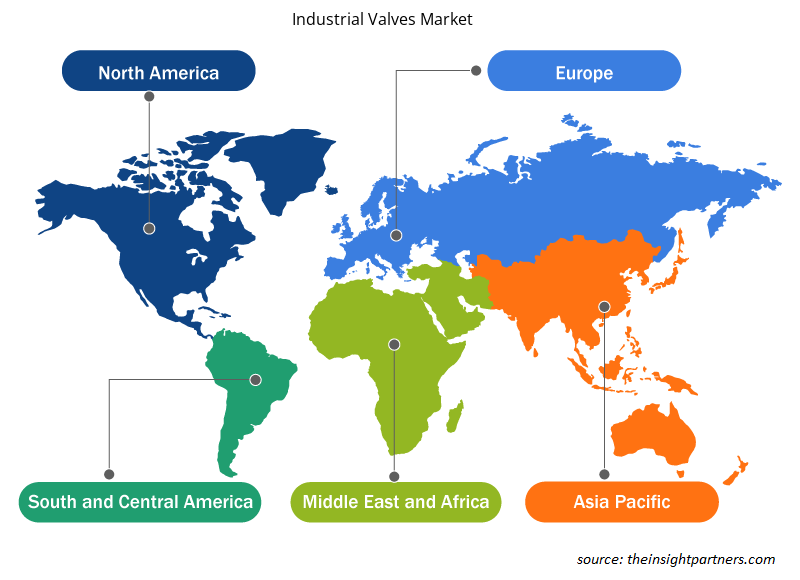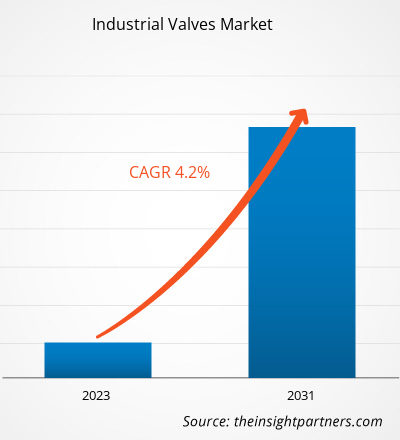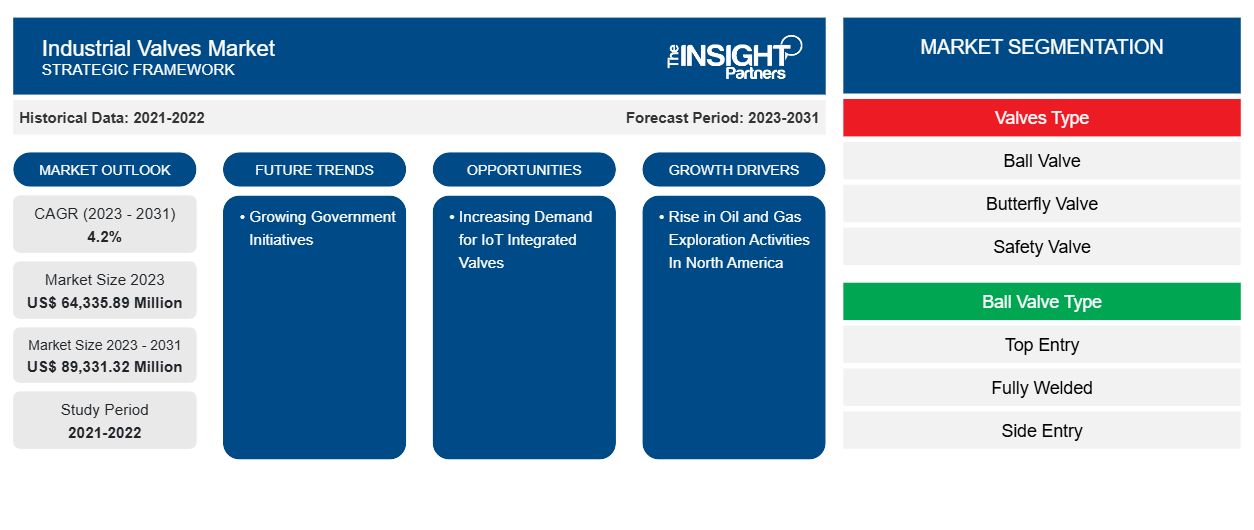Der Markt für Industrieventile soll von 64.335,89 Millionen US-Dollar im Jahr 2023 auf 89.331,32 Millionen US-Dollar im Jahr 2031 wachsen, mit einer durchschnittlichen jährlichen Wachstumsrate von 4,2 % bis 2031. Steigende Investitionen in die Stromerzeugung sowie die Öl- und Gasinfrastruktur auf der ganzen Welt dürften die Nachfrage nach Kugelhähnen ankurbeln, was wiederum das Marktwachstum im Prognosezeitraum ankurbeln dürfte. Darüber hinaus tragen ständige Entwicklungsinitiativen globaler Kugelhahnhersteller zum Marktwachstum bei. So kündigte Rusco im November 2021 die Einführung eines intelligenten, automatisierten Kugelhahns für die Heimfiltration, Brunnenwasser sowie gewerbliche und kommunale Anwendungen an, der mit Smartphones gekoppelt werden kann, um Programme zu automatisieren und die Sedimentspülung und Durchflussabschaltung zu steuern.
Marktanalyse für Industriearmaturen
Unternehmen auf dem globalen Markt für Industriearmaturen konzentrieren sich darauf, neue, verbesserte Produkte anzubieten, um den sich entwickelnden Bedürfnissen der Kunden gerecht zu werden. Im April 2022 brachte SANY UK das Mehrzweck-Rammgerät SR235 auf den Markt. Mit einem Betriebsgewicht von ~90 Tonnen wird das SR235 von einem Volvo-Motor der Stufe V angetrieben, was zu seiner Zuverlässigkeit und Effizienz beiträgt. Im Jahr 2019 führte Soilmec SpA neue SM-Bohrgeräte für die Gründung von Mikropfählen und die Verankerung ein. Im Mai 2021 stellte das Unternehmen neue mittelgroße Soilmec SM-11-Bohrgeräte vor, die über eine sehr hohe Förderkraft verfügen. Diese Geräte zeichnen sich durch eine geeignete Kombination aus Leistung und Effektivität aus und bieten ein kompaktes Unternehmen für Arbeitsplätze mit eingeschränktem Zugang. Darüber hinaus lassen sie sich leicht an unterschiedliche Arbeitsanforderungen anpassen. Im Januar 2020 erwarb Soilmec im Rahmen eines umfassenderen Projekts zur Sicherung des Wachstums auf ausländischen Märkten eine Mehrheitsbeteiligung an Watson Inc., einem in Texas ansässigen Hersteller von Fundamentgeräten. Daher werden solche jüngsten technologischen Entwicklungen und Produktinnovationen bei Rammmaschinen in den kommenden Jahren voraussichtlich neue Trends auf dem Markt hervorbringen.
Marktübersicht für Industrieventile
Eine Rammmaschine ist ein Gerät zum Einbringen von Pfählen oder Schächten in den Boden, um Bauwerke zu stützen. Rammmaschinen bohren in schlammigen Boden, sandigen Boden und andere. Diese Maschinen werden zum Bau von Wassertanks, Brücken, Gebäuden und Gründungsprojekten wie Fundamentbefestigungen, Grabenwänden und anderen verwendet. Eine Rammmaschine ist eine Baumaschine zum Einbringen in ein bestehendes Bauwerk. Sie wird hauptsächlich zum Bohren in sandigem Boden, Schlamm, schlammigem Boden und anderen verwendet. Sie wird häufig zum Bau von Pfählen, Grabenwänden, Fundamentbefestigungen und anderen Gründungsprojekten verwendet. Darüber hinaus ist es wichtig, die Position und Anordnung sorgfältig zu prüfen, da die Maschine durch eindringende Luft entweder beschädigt oder aus ihrer ursprünglichen Position verdrängt werden würde.
Passen Sie diesen Bericht Ihren Anforderungen an
Sie erhalten kostenlos individuelle Anpassungen an jedem Bericht, einschließlich Teilen dieses Berichts oder einer Analyse auf Länderebene, eines Excel-Datenpakets sowie tolle Angebote und Rabatte für Start-ups und Universitäten.
-
Holen Sie sich die wichtigsten Markttrends aus diesem Bericht.Dieses KOSTENLOSE Beispiel umfasst eine Datenanalyse von Markttrends bis hin zu Schätzungen und Prognosen.
Treiber und Chancen auf dem Markt für Industriearmaturen
Anstieg der Öl- und Gasexplorationsaktivitäten in Nordamerika
In der Öl- und Gasindustrie werden Industrieregelventile bei der Speicherung von Erdgas in kryogenen Temperaturbereichen eingesetzt, da sie bei Drücken von bis zu 750 psi und Temperaturen von bis zu -196 °C (-320 °F) effizient funktionieren. Darüber hinaus wächst der Öl- und Gassektor in Nordamerika von Jahr zu Jahr aufgrund der Entdeckung von Öl- und Gasbohranlagen. Darüber hinaus ist die Erdgasproduktion in den USA in den letzten Jahren erheblich gestiegen, da Verbesserungen der Bohrtechnologien die Gewinnung von in festen Formationen wie Schiefergestein und Kohle eingeschlossenem Gas kommerziell rentabel gemacht haben. Daher wird erwartet, dass der Anstieg der Exploration und Produktion von Öl und Gas im Land die Nachfrage nach Industrieventilen ankurbeln wird, was wiederum das Marktwachstum von 2023 bis 2031 ankurbeln dürfte.
Wachsende Regierungsinitiativen
Die Gaschromatographie ist eine analytische Technik, die in verschiedenen Branchen, einschließlich der Erdölindustrie, weit verbreitet ist, um Verbindungen zu trennen und zu analysieren. Am 1. Januar 2023 gab es in den USA 129 betriebsbereite Erdölraffinerien. Diese Raffinerien arbeiten kontinuierlich daran, die weltweite Nachfrage nach Erdölprodukten zu decken, was den Markt für Industrieventile weiter stärkt. Die USA waren 2022 nach China die zweitgrößte Nation in der verarbeitenden Industrie und Industrieproduktion. Im Jahr 2022 trug die verarbeitende Industrie 2.300 Milliarden US-Dollar bei und machte mehr als 11 % des gesamten US-BIP aus. Um die Industrieproduktion im gleichen Tempo zu steigern, müssen die Investitionen in die Entwicklung und Erweiterung der Infrastruktur erhöht werden, was wiederum in den kommenden Jahren eine Nachfrage nach Industrieventilen schaffen dürfte. Die US-Wirtschaft ist auf ein breites Infrastrukturnetz angewiesen, um ihre Position weltweit zu behaupten. Die derzeitige Infrastruktur in den USA ist veraltet und muss in den Sektoren Öl und Gas, Energie sowie Wasser und Abwasser modernisiert und die Kapazitäten erweitert werden. Nach Schätzungen der US-Umweltschutzbehörde wird die Trinkwasser- und Abwasserindustrie im nächsten Jahrzehnt Investitionen in Höhe von über 744 Milliarden US-Dollar benötigen. So verabschiedeten die USA im Jahr 2022 das Inflationsreduktionsgesetz, das darauf abzielt, 150 Milliarden US-Dollar für die Infrastrukturfinanzierung von Transport, sauberen Energieprojekten und anderer Infrastruktur bereitzustellen. Solche staatlichen Initiativen zur Entwicklung und Erweiterung der Infrastruktur in den USA dürften die Nachfrage nach Industrieventilen ankurbeln, was die Marktwachstumschancen in den kommenden Jahren ankurbeln dürfte.upgradation and capacity expansion in the sectors, including oil & gas, power, and water & wastewater, among others. As per the Environmental Protection Agency, it is estimated that the drinking water & wastewater industry will need more than US$ 744 billion in investment over the next decade. For instance, in 2022, the US passed the Inflation Reduction Act aimed at funding US$ 150 billion for infrastructure funding for transportation, clean energy projects, and other infrastructure. Such government initiatives toward the development and expansion of infrastructure in the US are expected to fuel the demand for industrial valves, which is projected to fuel the market growth opportunities in the coming years.
Segmentierungsanalyse des Marktberichts für Industrieventile
Wichtige Segmente, die zur Ableitung der Marktanalyse für Industrieventile beigetragen haben, sind der Ventiltyp.
- Basierend auf dem Ventiltyp ist der Markt für Industrieventile in Kugelhähne, Absperrklappen, Sicherheitsventile, Regelventile, Rückschlagventile, Kükenhähne und andere unterteilt. Das Segment Regelventile hatte im Jahr 2023 den größten Marktanteil.
Marktanteilsanalyse für Industrieventile nach Geografie
Der globale Markt für Industrieventile ist grob in Nordamerika, Europa, Asien-Pazifik (APAC), Naher Osten und Afrika (MEA) und Südamerika (SAM) unterteilt. Der asiatisch-pazifische Raum dominierte den Markt für Industrieventile im Jahr 2023 mit einem Anteil von 39,5 %; er wird den Markt im Prognosezeitraum weiterhin dominieren und bis 2031 einen Anteil von 41,9 % ausmachen. Der asiatisch-pazifische Raum dominierte den Markt für Industrieventile im Jahr 2023 mit einem Anteil von 39,5 %; er wird den Markt im Prognosezeitraum weiterhin dominieren und bis 2031 einen Anteil von 41,9 % ausmachen. Europa ist der zweitgrößte Beitragszahler zum globalen Markt für Industrieventile, gefolgt von Nordamerika.
Der Markt für Industrieventile ist grob in fünf große Regionen unterteilt: Nordamerika, Europa, Asien-Pazifik, Naher Osten und Afrika sowie Südamerika. Im Jahr 2023 führte der Asien-Pazifik-Raum den globalen Markt für Industrieventile mit einem Marktanteil von 39,5 % an, gefolgt von Europa und Nordamerika. Der Asien-Pazifik-Raum wird voraussichtlich die am schnellsten wachsende Region sein und von 2023 bis 2031 eine beeindruckende durchschnittliche jährliche Wachstumsrate von 5,0 % verzeichnen.
Auf dem globalen Markt für Industrieventile belegte Nordamerika mit einem Marktanteil von über 22,0 % im Jahr 2023 den dritten Platz. Nordamerika wird anhand der Präsenz gut entwickelter Länder wie den USA, Kanada und Mexiko analysiert, in denen die Öl- und Gasexploration, die Stromerzeugung und die Fertigungsaktivitäten in einem erheblichen Tempo wachsen. Die zunehmende Einführung fortschrittlicher und verbesserter Industrieventile treibt den nordamerikanischen Markt für Industrieventile an. Nordamerika gehört zu den größten Rohöl- und Erdgasproduzenten weltweit. Die USA sind der größte Ölproduzent weltweit mit einem Anteil von über 20 % an der Rohölproduktion. Darüber hinaus treibt die Präsenz mehrerer Chemie- und Petrochemieunternehmen und führender Akteure auf dem Markt für Industrieventile wie Emerson, Inc., Cameron-Schlumberger, Flowserve Corporation und Crane ChemPharma & Energy den nordamerikanischen Markt für Industrieventile an.
Regionale Einblicke in den Markt für Industrieventile
Die regionalen Trends und Faktoren, die den Markt für Industrieventile im Prognosezeitraum beeinflussen, wurden von den Analysten von Insight Partners ausführlich erläutert. In diesem Abschnitt werden auch Marktsegmente und Geografie für Industrieventile in Nordamerika, Europa, im asiatisch-pazifischen Raum, im Nahen Osten und Afrika sowie in Süd- und Mittelamerika erörtert.

- Erhalten Sie regionale Daten zum Markt für Industrieventile
Umfang des Marktberichts für Industrieventile
| Berichtsattribut | Details |
|---|---|
| Marktgröße im Jahr 2023 | 64.335,89 Millionen US-Dollar |
| Marktgröße bis 2031 | 89.331,32 Millionen US-Dollar |
| Globale CAGR (2023 - 2031) | 4,2 % |
| Historische Daten | 2021-2022 |
| Prognosezeitraum | 2023–2031 |
| Abgedeckte Segmente |
Nach Ventiltyp
|
| Abgedeckte Regionen und Länder |
Nordamerika
|
| Marktführer und wichtige Unternehmensprofile |
|
Dichte der Marktteilnehmer für Industriearmaturen: Auswirkungen auf die Geschäftsdynamik verstehen
Der Markt für Industrieventile wächst rasant, angetrieben durch die steigende Nachfrage der Endnutzer aufgrund von Faktoren wie sich entwickelnden Verbraucherpräferenzen, technologischen Fortschritten und einem größeren Bewusstsein für die Vorteile des Produkts. Mit steigender Nachfrage erweitern Unternehmen ihr Angebot, entwickeln Innovationen, um die Bedürfnisse der Verbraucher zu erfüllen, und nutzen neue Trends, was das Marktwachstum weiter ankurbelt.
Die Marktteilnehmerdichte bezieht sich auf die Verteilung der Firmen oder Unternehmen, die in einem bestimmten Markt oder einer bestimmten Branche tätig sind. Sie gibt an, wie viele Wettbewerber (Marktteilnehmer) in einem bestimmten Marktraum im Verhältnis zu seiner Größe oder seinem gesamten Marktwert präsent sind.
Die wichtigsten auf dem Markt für Industrieventile tätigen Unternehmen sind:
- Velan Inc
- Kranich GmbH
- CIRCOR International Inc
- Flowserve Corp
- Emerson Electric Co
- KITZ Corporation
Haftungsausschluss : Die oben aufgeführten Unternehmen sind nicht in einer bestimmten Reihenfolge aufgeführt.

- Überblick über die wichtigsten Akteure auf dem Markt für Industriearmaturen
Neuigkeiten und aktuelle Entwicklungen zum Markt für Industriearmaturen
Der Markt für Industriearmaturen wird durch die Erhebung qualitativer und quantitativer Daten nach Primär- und Sekundärforschung bewertet, die wichtige Unternehmensveröffentlichungen, Verbandsdaten und Datenbanken umfasst. Im Folgenden finden Sie eine Liste der Entwicklungen auf dem Markt für Innovationen, Geschäftserweiterungen und Strategien:
- Im April 2024 freut sich Flomatic Valves, ein führender Anbieter von Wasserkontrolllösungen, das neue 3-Zoll-Rückschlagventil Modell 745SC vorzustellen. Dieses Ventil erfüllt die Anforderungen des AWWA-Standards C508 und entspricht den Bestimmungen von American Iron & Steel (AIS) und gewährleistet so überlegene Leistung, Zuverlässigkeit und Vielseitigkeit. (Quelle: Flomatic Valves, Pressemitteilung)
- Im Dezember 2021 kündigt CIRCOR International, Inc., ein führender Hersteller und Vermarkter differenzierter Technologieprodukte und Subsysteme, das neue Steuerventil CIR 3100 an, ein kostengünstiges Ventilgehäuse mit zahlreichen internen Optionen für zahlreiche Anwendungen in einer Vielzahl von Branchen. (Quelle: CIRCOR International, Inc., Pressemitteilung)
Marktbericht zu Industriearmaturen – Umfang und Ergebnisse
Der Bericht „Marktgröße und Prognose für Industrieventile (2021–2031)“ bietet eine detaillierte Analyse des Marktes, die die folgenden Bereiche abdeckt:
- Marktgröße und Prognose für Industrieventile auf globaler, regionaler und Länderebene für alle abgedeckten wichtigen Marktsegmente.
- Marktdynamik wie Treiber, Beschränkungen und wichtige Chancen
- Markttrends für Industriearmaturen
- Detaillierte PEST/Porters Five Forces- und SWOT-Analyse
- Marktanalyse für Industriearmaturen mit Blick auf wichtige Markttrends, globale und regionale Rahmenbedingungen, wichtige Akteure, Vorschriften und aktuelle Marktentwicklungen
- Marktumfeld und Wettbewerbsanalyse für Industrieventile, einschließlich Marktkonzentration, Heatmap-Analyse, prominenten Akteuren und aktuellen Entwicklungen.
- Detaillierte Firmenprofile
- Historische Analyse (2 Jahre), Basisjahr, Prognose (7 Jahre) mit CAGR
- PEST- und SWOT-Analyse
- Marktgröße Wert/Volumen – Global, Regional, Land
- Branchen- und Wettbewerbslandschaft
- Excel-Datensatz
Aktuelle Berichte
Erfahrungsberichte
Grund zum Kauf
- Fundierte Entscheidungsfindung
- Marktdynamik verstehen
- Wettbewerbsanalyse
- Kundeneinblicke
- Marktprognosen
- Risikominimierung
- Strategische Planung
- Investitionsbegründung
- Identifizierung neuer Märkte
- Verbesserung von Marketingstrategien
- Steigerung der Betriebseffizienz
- Anpassung an regulatorische Trends























 Kostenlose Probe anfordern für - Markt für Industrieventile
Kostenlose Probe anfordern für - Markt für Industrieventile